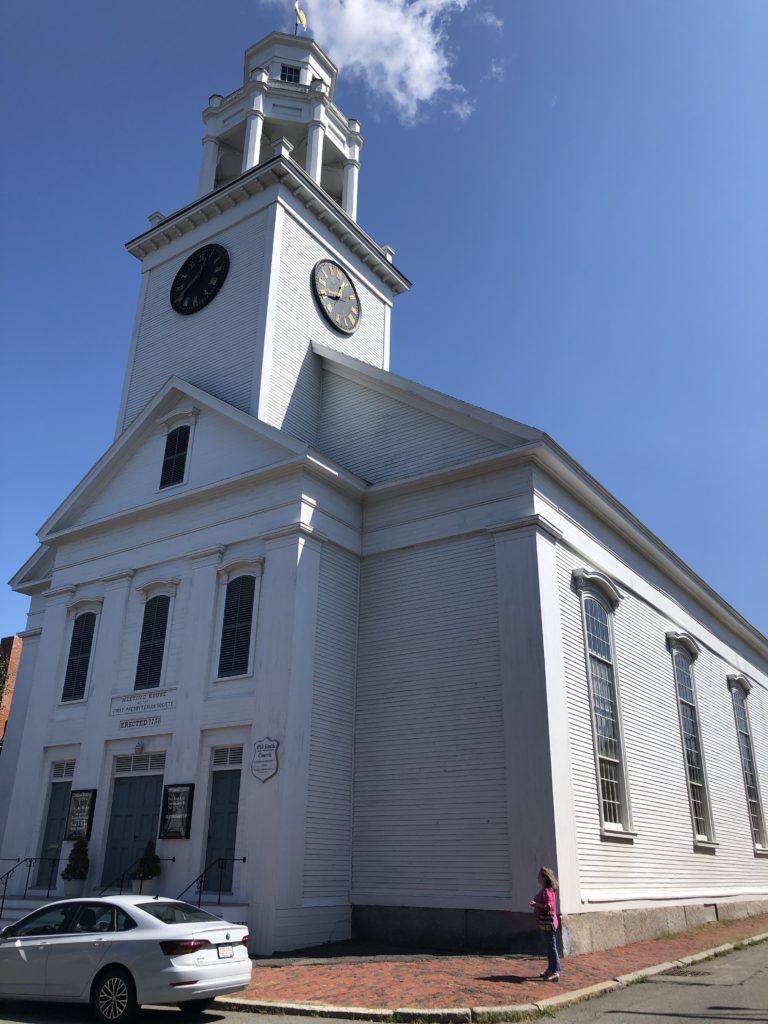
Our day began with a drive to Newburyport, Massachusetts that should have lasted an hour but took nearly two because of traffic and a stop at Dunkin Donuts. If you’ve not been to Boston, you may not know Dunkin Donuts has taken dominion over Boston. We counted five on a one-mile stretch on the road out of Boston, so we felt compelled to stop and see what all the fuss was about. I’m still trying to figure it out.
We went to Newburyport because that is the location of Old South Presbyterian Church (see pic above), where George Whitefield is buried. He died there on September 30, 1770, the morning after insisting on preaching the gospel one last time as he felt he was passing from this life to the next. He was buried in a crypt under the church.
Only, we made the mistake of coming on a Saturday when the church was closed, so we could only wander around outside and did not see the crypt. It was a disappointment to be sure, but with the disappointment came a surprise: the house next door was the house where William Lloyd Garrison (1805-1879), one of the most influential abolitionist of his day, was born.
Garrison’s abolitionist views arose from reading the Bible, and thereafter were published in his abolitionist newspaper, The Liberator. He was persecuted, beaten, and burned in effigy for his views. When slaves were finally emancipated in 1865, Garrison shut down his newspaper, having successfully fulfilled his calling. When Garrison died, Frederick Douglass, speaking of Garrison at a memorial service said, “It was the glory of this man that he could stand alone with the truth, and calmly await the result.” Garrison is a man who lived out the reality of I Corinthians 15:58: “Therefore, my beloved brothers, be steadfast, immovable, always abounding in the work of the Lord, knowing that in the Lord your labor is not in vain.”
After Newburyport, we drove to Salem, Massachusetts. Our expectations were low because we knew that most secular historians had misrepresented Cotton Mather’s role in the Salem Witch Trials and had falsely represented the trials as being based solely on religious hysteria. However, Salem was on the way back from Newburyport, and we felt we should see it.
Remarkably, as low as our expectations were, we were still disappointed. We had expected to find a quaint old town center and some old graveyards. As it turned out, there really is no old town Salem, and the town has commercialized the Salem Witch Trials even more than we had expected.
Cotton Mather’s book The Wonders of the Invisible World, was written following the Salem Witch Trials and, as a result, has more tightly connected him in history with the trials than he deserved. Mather was an intellectual, the youngest ever to graduate from Harvard. He spoke or wrote seven languages and is credited with discovery of the Small Pox vaccine, even though in doing so he was opposed by both the scientific and religious community. He was neither ignorant nor superstitious. Mather’s approach to the spirit realm was the right mix of the scientific and the spiritual. He recorded otherwise unexplainable physical manifestations of the spirit realm having been witnessed by multiple credible individuals at the same time.
The Puritans were practical Theonomists. They knew the New Testament didn’t address what to do with those who dabbled in the demonic, so they looked to the Old Testament for guidance. We can rightly condemn the Salem Witch Trials, but to suggest they were born purely out of ignorance or religious superstition just shows our ignorance….as does thinking we could easily find a parking place in this tourist trap of a town on Labor Day Weekend. In retrospect, I suppose one could conclude we should have kept driving, but still we enjoyed the weather, each others’ company, taking in all of what we saw and filtering it through the lens of the kingdom of God. GS

